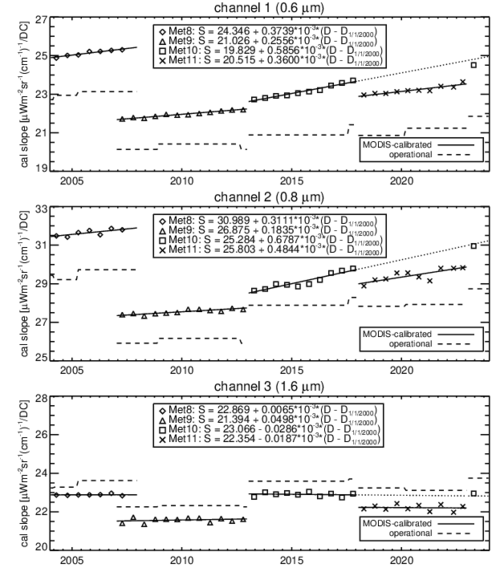MSG-SEVIRI solar channel calibration
MSG-SEVIRI solar channels are calibrated against the MODIS instrument following the methodology outlined in Meirink et al. (2013). This calibration has been extended to the full MSG era and updated using Aqua-MODIS Collection 6.1 reflectances as a reference.
The figure below shows the resulting calibration slopes for the 0.6 (top), 0.8 (middle) and 1.6 (bottom) micrometer SEVIRI channels from 2004 to 2023. Aqua-MODIS collocations for the months April and October of each year have been considered (symbols). Linear trend fits for the four satellites Meteosat-8 to Meteosat-11 are shown by the solid lines, and the coefficients of these fits are indicated (D - D1/1/2000 denotes the number of days since the beginning of 2000). The coefficients are also available in this text file.
The operational EUMETSAT calibration slopes are shown by dashed lines. In general, these are found to be between 5 and 15% too low for the 0.6 and 0.8 micron channels, and about 3% too high for the 1.6 micron channel.
Meteosat-10 took over full disk imagery from Meteosat-11 on 21 March 2023. The figure includes estimated calibration slopes (squares on the right of the plots) based on collocations between Meteosat-10 and Aqua-MODIS for the month of April 2023. These correspond very well with the trends determined from data between 2013 and 2017 (which are extended with dotted lines). This suggests that these trend lines can be used (unaltered) for the current Meteosat-10 full disk service.
Meirink, J.F., R.A. Roebeling and P. Stammes, 2013: Inter-calibration of polar imager solar channels using SEVIRI, Atm. Meas. Tech., 6, 2495-2508, doi:10.5194/amt-6-2495-2013
Last update: 4 May 2023
